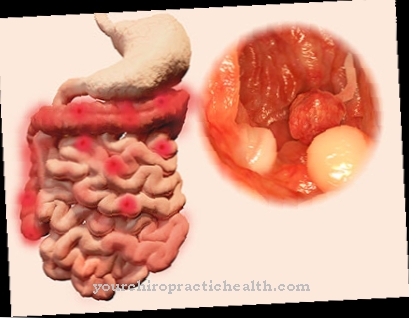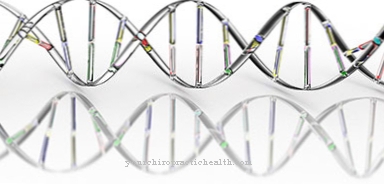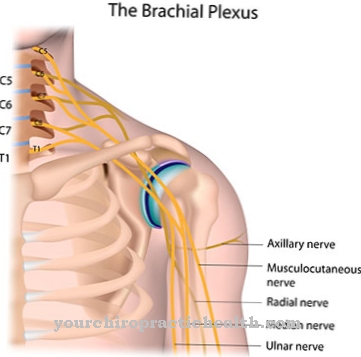Under the term Sick sinus syndrome a number of cardiac arrhythmias, so-called arrhythmias, are summarized, which is based on a malfunction of the sinus node. This disease mainly affects the elderly and is one of the most common indications for the implantation of a pacemaker.
What is Sick Sinus Syndrome?

© freshidea - stock.adobe.com
In healthy people, the sinus node is nothing more than a collection of specialized cells in the right ventricle that send out electrical signals at regular intervals.
In people with Sinus node syndrome These electrical impulses are given at the wrong intervals, which leads to a slowed or accelerated heart rhythm or a combination of both. Basically the term includes Sick sinus syndrome a large number of heart diseases which, in addition to the sinus malfunction from which it is named, can also be due to a blockage of the conduction of excitation via the atria.
A general definition of sick sinus syndrome is still pending. However, the term is used diagnostically to justify the indication of therapies with pacemakers and also, if a tachycardia-brachycardia syndrome is present, a special form of the sick sinus syndrome, characterized by the alternating occurrence of a too slow sinus rhythm, followed by a too fast.
causes
The causes of the Sick sinus syndrome are not infrequently idiopathic, i.e. without a known cause. In the course of life, small injuries to the sinus node tissue can occur, which lead to the formation of scar tissue, which blocks the conduction of excitation.
Sick sinus syndrome can also have mechanical causes, for example if the right atrium is overstretched during an operation. The most common cause, however, is high blood pressure, which puts a constant strain on the heart and can lead to overstretching due to the permanent overuse of the atria.
A sick sinus syndrome can also originate from inflammation of the heart muscle; the same is true of a number of other heart conditions such as mitral valve disease and coronary artery disease. Often, however, it is difficult or impossible to infer the causes of a diagnosed sick sinus syndrome.
Symptoms, ailments & signs
Sick sinus syndrome can manifest itself through a variety of symptoms, ailments, and signs. First and foremost, cardiovascular complaints occur: palpitations and high blood pressure or low pulse as well as cardiac arrhythmias. In addition, the symptoms resemble those of an AV block, which can lead to circulatory problems, dizziness, cramps and stabbing chest pain, among other things.
In extreme cases, the sick sinus syndrome leads to cardiac arrest. The sick sinus syndrome also favors the development of cardiac insufficiency, which greatly reduces physical stress and can trigger secondary diseases such as arteriosclerosis or arterial hypertension. Those affected experience increasing breathlessness and a feeling of oppression.
An inner restlessness is characteristic, which leads to a growing discomfort. This often leads to emotional problems, such as fear of death or depression. The arrhythmias can also cause visual disturbances. This manifests itself in the fact that the patient sees everything blurred or double. The visual problems are temporary and occur mainly during physical exertion.
They disappear again after a few minutes to hours. Nevertheless, they can have a negative impact on the quality of life and well-being of the sick. If the sick sinus syndrome is treated in time, long-term effects and serious complications can be avoided. An untreated arrhythmia can be fatal.
Diagnosis & course
The diagnosis of the Sick sinus syndrome can be set if the EKG results show certain abnormalities, such as atrial fibrillation and other abnormalities of the heart rhythm. The first choice for diagnosis is the long-term ECG, which allows the doctor to see whether bradycardias, tachycardias or even asystoles can be seen on the ECG.
In addition to this diagnostic measure, a stress ECG may also be necessary for diagnosis in order to determine whether the frequency increases with physical exertion. Long-term blood pressure measurements or cardiac catheter examinations may also be necessary, but remain an exception as a diagnostic tool for diagnosing sick sinus syndrome.
Complications
In sick sinus syndrome, most patients suffer from various heart ailments. In the worst case, these can lead to the death of the person concerned or significantly reduce life expectancy. The patients suffer from palpitations and also from a low pulse. This can lead to a loss of consciousness and thus possibly to a fall and injury.
Furthermore, illness-related difficulties in breathing and general inner restlessness. Those affected feel uncomfortable and also suffer from severe visual disturbances. In most cases, the visual problems are only temporary and then go away. The symptoms can occur especially during physical exertion and have a negative effect on the everyday life and quality of life of the patient.
In most cases, a healthy lifestyle has a very positive effect on the disease and can limit many symptoms. In severe cases, however, the use of a pacemaker is necessary in order to limit the symptoms of sick sinus syndrome. This can prevent further complaints or complications. Further regular examinations by the doctor are also necessary.
When should you go to the doctor?
Sick sinus syndrome should always be treated by a doctor. Only through early medical treatment can further complaints and complications be prevented that could otherwise limit the life expectancy of the person affected. In the worst case, the affected person suffers heart failure and dies as a result. In the case of sick sinus syndrome, a doctor should be consulted if the patient is suffering from heart problems. This leads to high blood pressure or palpitations, whereby these complaints occur without exertion and for no particular reason.
Furthermore, severe cramps or dizziness can indicate this disease and significantly reduce the quality of life of the person affected. Most patients also experience shortness of breath and severe visual problems. It is not uncommon for cramps or dizziness to indicate sick sinus syndrome and should also be examined by a doctor.The severity of the symptoms can be very different and depends largely on the severity of the disease.
Usually, sick sinus syndrome is diagnosed and treated by a cardiologist. The life expectancy of the person affected may also be reduced by the disease. Since the sick sinus syndrome can also lead to psychological upset or depression, a psychological examination and treatment should also be carried out.
Treatment & Therapy
In the treatment method of first choice, a distinction must be made between chronic and acute cardiac arrhythmias. So will with a chronic Sick sinus syndrome With bradycardia, i.e. phases in which the heart beats too slowly, the implantation of a pacemaker is generally recommended.
The pacemaker then takes over the function of the sinus node. The implantation of a pacemaker eliminates the symptoms and thus ensures a significant improvement in the patient's quality of life. If tachycardia occurs in the course of a chronic sick sinus syndrome, i.e. an excessive increase in cardiac activity, antiarrhythmic medication can often be used and a pacemaker can only be considered after monitoring the course and administering medication.
If bradycardia and tachycardia alternate, a pacemaker implantation is unavoidable. In addition, antiarrhythmic drugs must be taken after the implantation to prevent tachycardiac phases. In acute cases of bradycadia, atropine is administered intravenously. If the atrium is enlarged and atrial fibrillation occurs, treatment is usually given with anticoagulants, drugs that inhibit blood clotting, in order to prevent complications such as a stroke.
prevention
Prophylaxis to avoid the occurrence of a Sick sinus syndrome There is hardly any prevention, as the causes usually differ from person to person and often cannot be determined with certainty. Regular blood pressure checks and any treatment for high blood pressure are likely to be one of the few concrete measures to prevent sinus node disease.
Basically, what is good for the heart is also good to prevent sick sinus syndrome. This means that a healthy lifestyle, sufficient exercise and a balanced diet can do a lot to maintain a healthy, functional heart.
Aftercare
In the case of sick sinus syndrome, those affected usually have only a few options for follow-up care available, so that the patient should ideally consult a doctor at an early stage in order to prevent other complaints and complications from occurring. As a rule, self-healing cannot occur, so that the person affected is always dependent on medical treatment.
The earlier a doctor is consulted, the better the further course of this disease is usually. Many of those affected by sick sinus syndrome are dependent on the intake of various medications. Regular intake and the correct dosage should always be observed, if you have any questions or if anything is unclear, a doctor should always be contacted first.
The doctor should also be consulted in the event of side effects. In many cases, the help of friends and relatives is very important in everyday life to alleviate the symptoms. Contact with other patients can also be useful in the case of sick sinus syndrome, as this leads to an exchange of information that could make everyday life easier for the person concerned.
You can do that yourself
Patients with sick sinus syndrome should make sure that the heart is relieved. In everyday life, emotional as well as physical stressors must therefore be reduced to a minimum. Physical overexertion leads to an increase in the activity of the cardiovascular system. It is therefore important to ensure that the physical movements do not lead to excessive stress. Sports as well as professional activities must be coordinated with the requirements of the organism and should not be exceeded.
As soon as the first irregularities or changes in health appear, breaks should be taken. The organism needs time for sufficient regeneration. If the physical signals are ignored, life-threatening complications can arise.
In addition to physical resilience, emotional stress factors must also be minimized. Conflicts, a hectic daily routine or numerous interpersonal disagreements can be an immense mental burden. Relaxation techniques help to better cope with and process everyday events. In addition, cognitive procedures are to be used if circular thoughts occur and the person concerned experiences strong inner restlessness. Breathing techniques and clear boundaries in everyday life can be helpful in relieving the symptoms. In states of fear, awareness processes help to minimize them. If the person concerned needs help with this, he should seek cooperation with a therapist.




.jpg)











.jpg)
.jpg)



.jpg)






